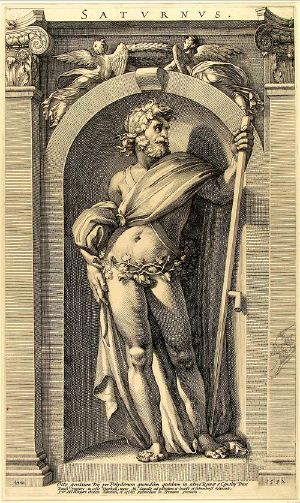Saturn (mythology)
Saturn (Latin: Saturnus) was a major Roman deity of agriculture and harvest. He was identified in classical antiquity with the Greek deity Cronus, and the mythologies of the two gods are commonly mixed.
Saturn's wife was Rhea's equivalent — not Magna Mater. Saturn was the father of Ceres, Jupiter, and Veritas, among others. Saturn had a temple on the Forum Romanum which contained the Royal Treasury. Saturn is the namesake of Saturday (dies Saturni), the only day of the week to retain its Roman name in English. The planet Saturn is also named after the Roman god, being the furthest observable planet of the seven classical planets of antiquity.
Later concept
- Further information: Cronus
In Hesiod's Theogony, a mythological account of the creation of the universe and Zeus' rise to power, Saturn is mentioned as the son of Uranus, the heavens, and Gaia, the earth. Hesiod is an early Greek poet and rhapsode, who presumably lived around 700 B.C.E. He writes that Saturn seizes power, castrating and overthrowing his father Uranus. However, it was foretold that one day a mighty son of Saturn would in turn overthrow him, and Saturn devoured all of his children when they were born to prevent this. Saturn's wife, Ops, hid her sixth child on the island of Crete, and offered Saturn a large stone wrapped in swaddling clothes in his place. Jupiter later overthrew Saturn and the other Titans, becoming the new supreme ruler of the cosmos.
In memory of the Golden Age of man, a mythical age when Saturn was said to have ruled, a great feast called Saturnalia was held during the winter months around the time of the winter solstice. It was originally only one day long, taking place on December 17, but later lasted one week. During Saturnalia, roles of master and slave were reversed, moral restrictions lessened, and the rules of etiquette ignored. It is thought that the festivals of Saturnalia and Lupercalia were the roots of the carnival season.
Although Saturn changed greatly over time due to the influence of Greek mythology, he was also one of the few distinct Roman deities to predate and retain elements of his original function. As Thomas Paine wrote:
It is impossible for us now to know at what time the heathen mythology began; but it is certain, from the internal evidence that it carries, that it did not begin in the same state or condition in which it ended. All the gods of that mythology, except Saturn, were of modern invention. The supposed reign of Saturn was prior to that which is called the heathen mythology, and was so far a species of theism that it admitted the belief of only one God. Saturn is supposed to have abdicated the govemment in favour of his three sons and one daughter, Jupiter, Pluto, Neptune, and Juno; after this, thousands of other gods and demigods were imaginarily created, and the calendar of gods increased as fast as the calendar of saints and the calendar of courts have increased since.
ReferencesISBN links support NWE through referral fees
- Lenardon, Robert J, et al. "A Companion to Classical Mythology" Oxford University Press, 1996. ISBN 978-0195147254
- Morford, Mark P. O. & Lenardon, Robert J. "Classical Mythology" Oxford University Press, 2002. ISBN 978-0195153446
- Osborn, Kevin. "The Complete Idiot's Guide to Classical Mythology" Alpha, 1998. ISBN 978-0028623856
Credits
New World Encyclopedia writers and editors rewrote and completed the Wikipedia article in accordance with New World Encyclopedia standards. This article abides by terms of the Creative Commons CC-by-sa 3.0 License (CC-by-sa), which may be used and disseminated with proper attribution. Credit is due under the terms of this license that can reference both the New World Encyclopedia contributors and the selfless volunteer contributors of the Wikimedia Foundation. To cite this article click here for a list of acceptable citing formats.The history of earlier contributions by wikipedians is accessible to researchers here:
The history of this article since it was imported to New World Encyclopedia:
Note: Some restrictions may apply to use of individual images which are separately licensed.
